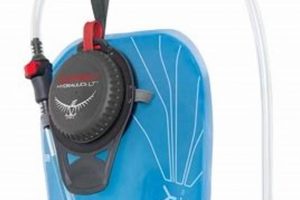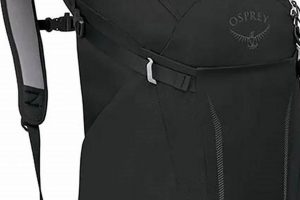Pre-owned carrying solutions from Osprey represent a market segment focused on affordability and sustainability. These items, typically backpacks designed for hiking, travel, or everyday carry, have been previously owned and utilized before being offered for resale. For instance, a lightly-used Atmos AG 65 backpack, originally purchased for extended backpacking trips, may find a second owner seeking a cost-effective solution for shorter excursions.
The availability of these items allows consumers to access high-quality, durable products at a reduced price, fostering responsible consumption and minimizing waste. This approach extends the lifespan of durable goods, aligning with environmental sustainability goals. Historically, the practice of buying and selling pre-owned gear has offered economic benefits, especially within communities of outdoor enthusiasts, fostering resourcefulness and shared access to equipment.
The following sections will address the advantages and disadvantages of procuring these items, key factors to consider when evaluating potential purchases, and platforms available for facilitating these transactions. This examination aims to provide prospective buyers with the information needed to make informed decisions within this marketplace.
Tips for Acquiring Pre-Owned Osprey Backpacks
The acquisition of pre-owned Osprey backpacks presents a cost-effective avenue for obtaining high-quality gear. However, prospective buyers should exercise diligence to ensure satisfaction with the purchase.
Tip 1: Thoroughly Inspect for Damage. Prior to purchase, a comprehensive inspection is crucial. Examine all seams, zippers, buckles, and fabric for signs of wear, tears, or damage. Pay particular attention to high-stress areas like shoulder straps and hip belts. For example, a small tear in the bottom of the pack could quickly expand, compromising its utility.
Tip 2: Assess Suspension System Integrity. The suspension system, including the frame, hip belt, and shoulder straps, is critical for comfortable load carriage. Ensure the frame is intact and not bent or broken. Test the adjustability of the hip belt and shoulder straps to confirm they function correctly. A compromised suspension system can lead to discomfort and potential injury.
Tip 3: Verify Zipper Functionality. Zippers are a common point of failure in used gear. Test each zipper thoroughly to ensure smooth operation. Check for missing teeth or damaged sliders. Consider replacing zippers if necessary, factoring the cost into the overall purchase decision. Sticking or broken zippers can render pockets and compartments unusable.
Tip 4: Evaluate Fabric Condition. Assess the fabric for excessive fading, staining, or deterioration. Faded fabric may indicate prolonged exposure to sunlight, which can weaken the material. Stains may be difficult to remove and could indicate unsanitary conditions. Look for signs of delamination, where the waterproof coating separates from the fabric.
Tip 5: Inquire About Usage History. If possible, obtain information about the backpack’s usage history from the seller. Understanding how frequently the item was used and the types of activities it was subjected to can provide valuable insight into its current condition and potential lifespan.
Tip 6: Compare Prices and Models. Research current market prices for both new and used Osprey backpacks to ensure a fair deal. Consider the specific model and its features to determine if it meets the intended use. Different models are designed for different activities and load capacities.
Tip 7: Consider Hygiene. Used backpacks may harbor bacteria or odors from previous use. Thoroughly clean and disinfect the pack before use. Consider using a gear-specific cleaner to avoid damaging the fabric or coatings.
Adhering to these guidelines will increase the likelihood of acquiring a satisfactory pre-owned Osprey backpack, offering a balance between cost savings and product performance.
The subsequent section will explore various platforms for purchasing pre-owned Osprey backpacks, highlighting the pros and cons of each.
1. Condition Assessment
Condition assessment is paramount when considering used Osprey backpacks. The pre-owned nature of these items inherently implies prior use, potentially resulting in varying degrees of wear and tear that directly impacts functionality and longevity. A backpack exhibiting significant abrasion on its exterior fabric, for example, signals a compromised resistance to the elements, reducing its effectiveness in wet or abrasive conditions. Deficiencies discovered during condition assessment, such as damaged zippers, frayed straps, or compromised stitching, reveal potential points of failure that necessitate repair or affect the backpack’s carrying capacity. The overall integrity and performance of the backpack are directly linked to its condition.
The implications of inadequate condition assessment can range from minor inconveniences to critical equipment failures in the field. A seemingly insignificant tear in a load-bearing strap, overlooked during a cursory inspection, could lead to complete strap detachment under heavy load, potentially resulting in injury or loss of gear. Conversely, a detailed assessment revealing only superficial cosmetic damage might present an opportunity to acquire a fully functional backpack at a significantly reduced price. Thorough condition assessment empowers prospective buyers to make informed decisions, weighing the cost of potential repairs against the savings achieved through purchasing a pre-owned item.
In summary, meticulous condition assessment is an indispensable step in the acquisition of used Osprey backpacks. It serves as the primary means of evaluating the backpack’s current state, identifying potential weaknesses, and predicting its future performance. This process enables informed decision-making, ensuring that the purchased item aligns with the intended use and offers a suitable balance between cost, functionality, and expected lifespan. Failing to prioritize condition assessment significantly increases the risk of acquiring a substandard or unsuitable item, potentially undermining the intended benefits of purchasing pre-owned gear.
2. Price Variation
Price variation within the market for pre-owned Osprey backpacks is a direct consequence of several interconnected factors, primarily condition, model rarity, and marketplace dynamics. A near-mint condition Atmos AG 65, for example, will command a significantly higher resale price than the same model with visible wear, tears, or modifications. Furthermore, discontinued or limited-edition models often exhibit amplified price fluctuations due to scarcity and collector demand. Online marketplaces, such as eBay or dedicated gear resale platforms, introduce additional variability based on seller competition, auction dynamics, and shipping costs. Consequently, the prudent buyer must navigate a complex landscape of prices, requiring diligent research and comparative analysis to identify fair market value.
Understanding the causes of price variation is critical for both buyers and sellers operating within this secondary market. For buyers, recognizing the correlation between condition and price allows for informed decisions regarding investment versus potential repair costs. A heavily discounted backpack with repairable damage may represent a cost-effective solution for a budget-conscious individual willing to undertake minor restoration. Conversely, a seller equipped with knowledge of model rarity and market demand can optimize listing strategies to maximize resale value. Ignorance of these factors can lead to overpayment or missed opportunities for profitable transactions. Real-world examples of significant price disparities abound; a cursory search will reveal identical models listed at vastly different prices, reflecting the subjective assessments of individual sellers and the efficiency (or inefficiency) of the marketplace.
In conclusion, price variation is an intrinsic characteristic of the used Osprey backpack market, driven by condition, rarity, and marketplace dynamics. A comprehensive understanding of these drivers empowers both buyers and sellers to navigate the market effectively, ensuring equitable transactions and maximizing the value derived from pre-owned outdoor equipment. This knowledge mitigates the risk of overpayment, facilitates informed purchasing decisions, and ultimately promotes a more sustainable and resource-conscious approach to acquiring outdoor gear. The ongoing challenge lies in developing standardized methods for condition assessment and price benchmarking to enhance transparency and reduce information asymmetry within the market.
3. Authenticity Verification
The prevalence of counterfeit goods extends to the market for used Osprey backpacks, necessitating rigorous authenticity verification procedures. The brand’s reputation for durability and ergonomic design makes it a target for counterfeiters seeking to profit from deceptive imitations. Purchasing a purportedly used Osprey backpack that is, in reality, a poorly manufactured replica results in significant performance deficits and diminished lifespan. For example, a counterfeit backpack might utilize inferior materials, resulting in premature tearing or failure of load-bearing seams under stress. This poses a safety risk, especially during outdoor activities where equipment reliability is paramount. The absence of genuine Osprey components, such as accurately designed suspension systems or properly treated fabrics, further compromises the user experience and negates the benefits associated with the brand.
Verification methodologies involve scrutinizing key identifying features characteristic of authentic Osprey products. Serial numbers, typically located within the backpack’s interior, can be cross-referenced with Osprey’s customer service database to confirm production dates and model specifications. Stitching patterns, zipper brands (often YKK), and the quality of the Osprey logo embroidery are further indicators of authenticity. Close examination of the fabric’s texture and composition can reveal inconsistencies indicative of counterfeit materials. Furthermore, comparing the weight and dimensions of the used backpack with published specifications for the corresponding model is a valuable verification step. Online forums dedicated to outdoor gear often feature discussions and visual guides detailing identifying characteristics of genuine Osprey products, providing valuable resources for prospective buyers. Reliance solely on visual inspection may prove inadequate; seeking expert opinions or utilizing professional authentication services offers enhanced assurance.
In conclusion, authenticity verification is an indispensable component of acquiring used Osprey backpacks. The potential consequences of purchasing a counterfeit item extend beyond financial loss, encompassing safety risks and performance degradation. By diligently employing established verification techniques and consulting available resources, buyers can mitigate the risk of encountering counterfeit products and ensure they are investing in genuine Osprey quality. The responsibility for vigilance rests upon the purchaser, as marketplace platforms often lack robust mechanisms for preventing the sale of counterfeit goods. A proactive approach to authenticity verification safeguards the investment and guarantees access to the intended benefits of owning an authentic Osprey backpack.
4. Usage History
The prior usage of Osprey backpacks significantly influences their condition, performance, and suitability for subsequent use. Understanding a backpack’s history provides critical insights into its remaining lifespan and potential limitations.
- Frequency of Use
The regularity with which a backpack has been used directly impacts its structural integrity. A pack used daily for commuting experiences different stresses than one used only occasionally for weekend hikes. Daily use often leads to accelerated wear on zippers, straps, and fabric. Frequent abrasion against rough surfaces, constant exposure to sunlight, and repetitive loading all contribute to gradual deterioration.
- Types of Activities
The environments and activities for which a backpack was used dictate the types of wear and tear it may have sustained. A pack primarily used for air travel may exhibit different wear patterns than one subjected to rugged backcountry conditions. Backpacks used for mountaineering, for example, are likely to have experienced more severe abrasion, exposure to extreme weather, and potential impacts from rocks or ice. Knowing the specific activities provides a better understanding of the stresses the pack has endured.
- Load Carried
The weight and distribution of loads carried within a backpack exert considerable force on its suspension system, frame, and fabric. Overloading a pack beyond its recommended capacity can cause permanent deformation, stretching, or tearing of critical components. A pack consistently used to carry heavy loads may exhibit weakened seams, stressed zippers, or compromised padding in the hip belt and shoulder straps. Understanding the typical weight carried within the pack offers valuable insights into its structural health.
- Maintenance Practices
The level of care and maintenance a backpack has received significantly affects its longevity. Regular cleaning, proper storage, and timely repairs can extend the lifespan of a pack considerably. Conversely, neglect, such as improper storage in damp conditions or failure to address minor damages, can accelerate deterioration. Knowledge of maintenance practices provides a comprehensive view of how well the backpack has been preserved and its potential for future use.
These facets of usage history, taken together, provide a comprehensive assessment of a pre-owned Osprey backpack’s current state and its suitability for future adventures. Neglecting to consider these factors can lead to disappointment or even equipment failure in critical situations. A detailed understanding of a backpack’s past is essential for making informed purchasing decisions and ensuring a safe and enjoyable experience.
5. Durability Expectations
The purchase of a pre-owned Osprey backpack inherently involves navigating the complex relationship between prior usage and anticipated longevity. A primary driver behind selecting Osprey products, whether new or used, resides in the brand’s established reputation for robust construction and enduring performance. However, durability expectations for a pre-owned item must necessarily differ from those applied to a new counterpart. Prior use invariably introduces a degree of wear and tear, reducing the remaining lifespan and potentially affecting the backpack’s capacity to withstand demanding conditions. A used pack, irrespective of its original quality, cannot be expected to perform identically to a new one, particularly concerning resistance to abrasion, water penetration, or load-bearing capacity. Failing to calibrate durability expectations in alignment with the item’s age and usage history increases the risk of disappointment and premature equipment failure.
The alignment of durability expectations with the actual condition of a pre-owned Osprey backpack directly influences the selection process. A prospective buyer seeking a backpack for extended backcountry trips, where reliability is paramount, should prioritize packs with minimal evidence of wear and tear, despite potentially higher prices. Conversely, an individual requiring a backpack for light recreational use, such as day hikes or urban commuting, may find a more heavily used pack entirely suitable, provided that critical components like zippers and straps remain functional. Prioritizing specific needs and adjusting durability expectations accordingly allows for a more informed decision-making process, ensuring that the selected backpack meets the intended application requirements without unnecessary expenditure. Documented examples exist of purchasers regretting decisions to prioritize price over condition, resulting in equipment failures during critical moments, highlighting the practical significance of aligning expectations with reality.
In summation, realistic durability expectations are a crucial determinant of satisfaction when acquiring pre-owned Osprey backpacks. The inherent compromises associated with pre-owned items necessitate a careful balance between cost savings and anticipated performance. Understanding the impact of prior usage on structural integrity, factoring in the intended application, and calibrating durability expectations accordingly are essential steps toward ensuring a successful purchase. While pre-owned Osprey backpacks can offer exceptional value, particularly for budget-conscious consumers, a failure to acknowledge and address durability expectations can lead to both financial disappointment and compromised safety in the field. The ongoing challenge lies in developing more standardized methods for quantifying and communicating the remaining lifespan and performance capabilities of pre-owned outdoor gear, fostering greater transparency and informed decision-making within the secondary market.
Frequently Asked Questions
This section addresses common inquiries and concerns regarding the acquisition and utilization of pre-owned Osprey backpacks, providing factual information to guide informed decisions.
Question 1: What are the primary advantages of purchasing a used Osprey backpack?
The primary advantage is cost savings. Pre-owned backpacks are generally offered at a lower price point than new models, enabling access to high-quality gear at a reduced financial investment. Furthermore, purchasing used items promotes sustainability by extending product lifecycles and reducing waste.
Question 2: What are the key factors to consider when assessing the condition of a used Osprey backpack?
Critical factors include examining the fabric for tears, abrasions, or discoloration; inspecting zippers for smooth operation and intact teeth; evaluating the integrity of straps and buckles; and assessing the overall functionality of the suspension system. Special attention should be paid to high-stress areas.
Question 3: How can one verify the authenticity of a used Osprey backpack to avoid purchasing a counterfeit item?
Verification methods include comparing the item’s serial number with Osprey’s database, scrutinizing the quality of stitching and materials, and examining the presence of genuine Osprey components, such as YKK zippers. Consulting online resources and comparing the item with known authentic models can also aid in authentication.
Question 4: What steps should be taken to clean and sanitize a used Osprey backpack before use?
The backpack should be thoroughly cleaned with a gear-specific cleaner according to the manufacturer’s instructions. Ensure all compartments are emptied and vacuumed to remove debris. Allow the backpack to air dry completely in a well-ventilated area to prevent mildew growth.
Question 5: What is a reasonable expectation for the lifespan of a used Osprey backpack, considering prior use?
Lifespan expectations vary significantly depending on the backpack’s age, usage history, and condition. A well-maintained pack with minimal wear may offer several years of reliable service, while a heavily used pack may have a limited remaining lifespan. Inspecting the pack for signs of imminent failure is crucial.
Question 6: Are there specific types of damage that render a used Osprey backpack unsuitable for purchase?
Significant damage to the suspension system, such as a broken frame or severely damaged straps, generally renders a backpack unsuitable. Extensive fabric damage, including large tears or widespread delamination of waterproof coatings, also compromises functionality. Non-repairable zipper failures can render compartments unusable.
In summary, the acquisition of a used Osprey backpack necessitates a thorough assessment of condition, authenticity, and usage history. Adhering to recommended cleaning and inspection procedures maximizes the potential for a satisfactory purchase.
The subsequent section will explore specific marketplaces and platforms for acquiring pre-owned Osprey backpacks, highlighting the advantages and disadvantages of each.
used osprey backpacks
The preceding discussion has detailed various facets pertinent to pre-owned carrying solutions. Key considerations encompass condition assessment, authenticity verification, and an understanding of usage history to establish reasonable durability expectations. These factors collectively influence the value proposition and long-term suitability of such acquisitions.
Prospective purchasers are urged to exercise diligence in evaluating pre-owned inventory. The responsible acquisition and utilization of equipment not only provides economic benefits but also contributes to a more sustainable consumption model within the outdoor recreation sphere. Continued advancements in condition assessment methodologies and marketplace transparency will further empower informed decision-making in this sector.







![Best Osprey Kestrel 38L Backpack [Review & Guide] Ultimate Backpack Traveler Guide: Tips, Destinations & Budget Hacks Best Osprey Kestrel 38L Backpack [Review & Guide] | Ultimate Backpack Traveler Guide: Tips, Destinations & Budget Hacks](https://backpack-traveler.com/wp-content/uploads/2025/10/th-816-300x200.jpg)